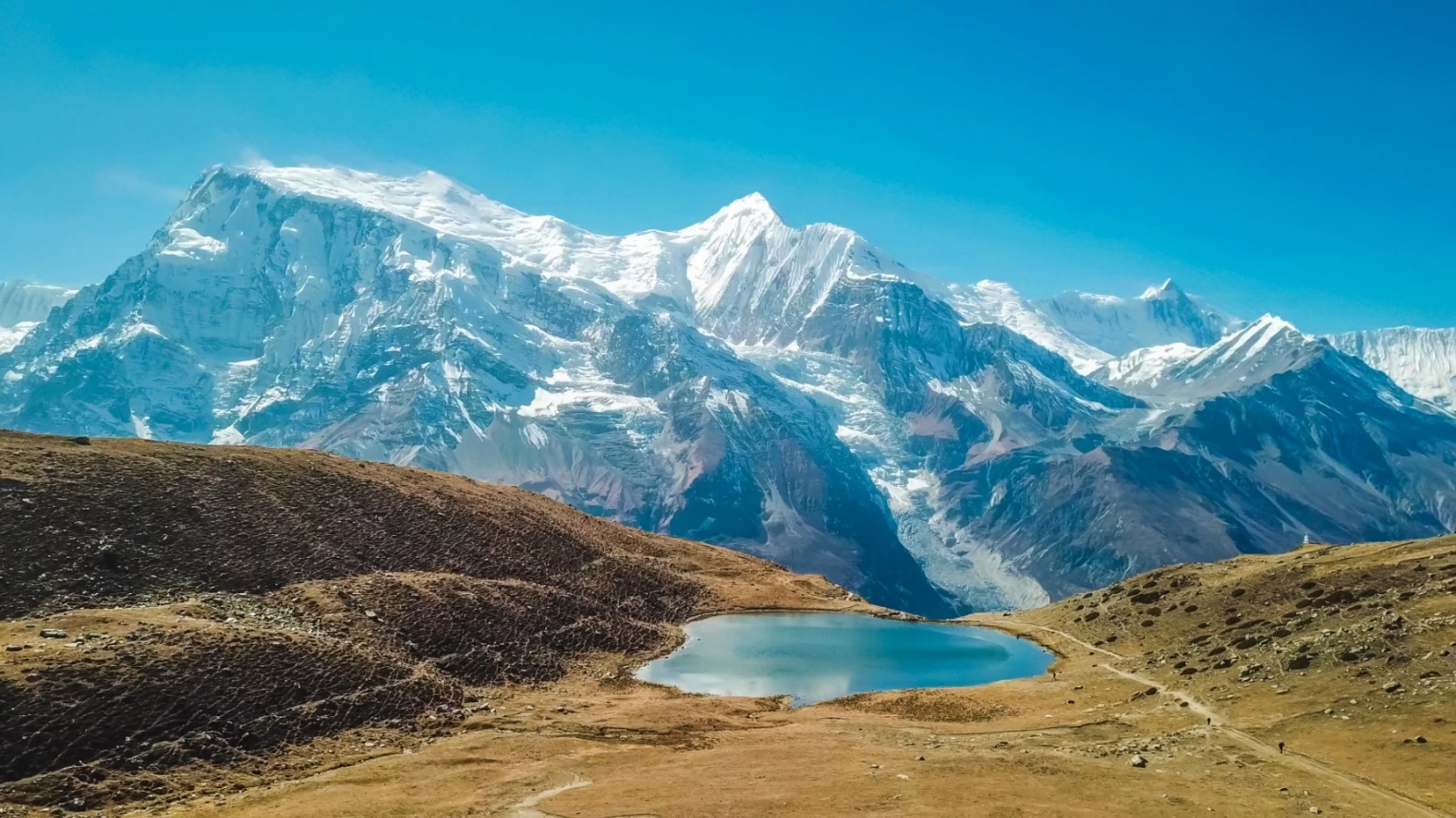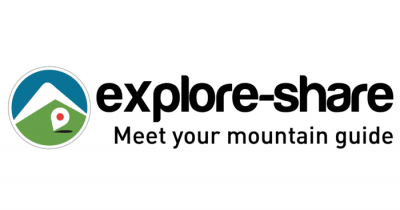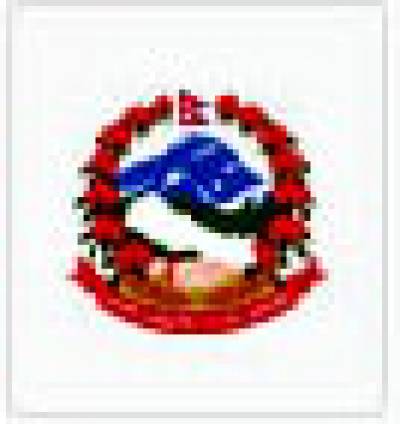ANNAPURNA CIRCUIT WITH TILICHO LAKE TREK 17 DAYS
The 17-Day Annapurna Circuit with Tilicho Lake Trek offers an exhilarating and demanding journey through the Annapurna region, renowned for its breathtaking mountain views, diverse landscapes, and vibrant cultural heritage.
Your adventure begins upon arrival in Kathmandu, followed by a scenic drive to Besisahar and a jeep ride to Dharapani, marking the official start of your trek. As you progress, you'll pass through charming villages like Pisang and Manang, offering spectacular views of surrounding peaks and providing an opportunity to immerse yourself in the local culture. A rest day in Manang ensures proper acclimatization before ascending to higher altitudes.
The trek then leads you towards Shree Kharka, as you move through more remote regions, eventually reaching Tilicho Base Camp. Here, you'll visit Tilicho Lake, the highest lake in the world at 4,949 meters. The pristine beauty of the lake and the surrounding mountains offers one of the most remarkable sights of the trek. After enjoying the lake, you’ll retrace your steps to Shree Kharka before continuing on to Yak Kharka and Thorong Phedi, the final stop before the legendary Thorong La Pass at 5,416 meters. Crossing the pass is a monumental achievement, rewarded with panoramic views of the Annapurna and Dhaulagiri ranges.
After descending from the pass, you'll reach Muktinath, a sacred pilgrimage site for both Hindus and Buddhists, where you can explore the Muktinath Temple. The trek continues with a jeep ride to Tatopani, famous for its natural hot springs—perfect for relaxation and muscle recovery.
Next, the trek takes you to Ghorepani, followed by a sunrise excursion to Poon Hill, which provides some of the most stunning panoramic views of the Annapurna and Dhaulagiri mountain ranges. The trek concludes with a descent to Nayapul, followed by a scenic drive to Pokhara, and then back to Kathmandu for your final departure.
This 17-day trek offers a challenging yet incredibly rewarding adventure through the heart of the Himalayas, leaving you with unforgettable memories of the Annapurna region’s majestic beauty.
ITINERARY
Day 1 : Arrival in Kathmandu and Transfer to Hotel.
Arrive at Tribhuvan International Airport in Kathmandu, Nepal's bustling capital. Upon arrival, you'll be greeted by your guide or a representative from your trekking agency. After a warm welcome, you’ll be transferred to your hotel. Spend the rest of the day at leisure, allowing yourself to acclimatize to the new time zone and surroundings. You can explore the city’s vibrant streets, visit local markets, or rest for the exciting adventure ahead. Kathmandu is a mix of modern life and ancient traditions, with temples and monasteries to explore.
Day 2 : Drive from Kathmandu to Dharapani via Besisahar (8-10 hours)
The journey starts with a scenic drive from Kathmandu to Besisahar, the starting point of the Annapurna Circuit. The 8-10 hour drive is a blend of bumpy mountain roads and picturesque views of terraced fields, rivers, and hills. You’ll pass through several towns, including Khudi and Besisahar, where the road conditions improve. After reaching Besisahar, you will continue your drive in a jeep to Dharapani, your trek's first stop, nestled at a lower altitude. This marks the beginning of the Annapurna Circuit journey.
Day 3 : Trek from Dharapani to Chame (2,650m) – 5-6 hours.
Today marks your first day on foot as you begin the trek towards Chame, the administrative center of the Manang District. Starting from Dharapani, you’ll follow a winding trail through forests of pine and fir trees and pass several small villages, such as Bagarchhap. The path continues along the Marsyangdi River. As you ascend, the majestic views of the Annapurna range begin to unfold before you. You’ll reach Chame in the late afternoon, where you can rest and take in the breathtaking mountain vistas.
Day 4 : Trek from Chame to Pisang (3,300m) – 5-6 hours.
On this day, the trek continues towards Pisang, which is located at a higher altitude, offering incredible views of the Pisang Peak and Lamjung Himal. The 5-6 hour trek follows a steadily ascending path through pine forests and open pastures. The landscape begins to change as you move from dense forest to more barren terrain, and you may see yaks grazing along the trail. Once you arrive in Pisang, you’ll notice the local Tibetan influence in the architecture and lifestyle. You can also explore the village's Tibetan monasteries during your stay.
Day 5 : Trek from Pisang to Manang (3,500m) via Ngawal – 6-7 hours.
The trek today takes you to Manang, a larger village that is a popular resting point for trekkers. The day’s journey is about 6-7 hours long. The route passes through Ngawal, a charming village with traditional stone houses and stunning views of the surrounding peaks. The higher you climb, the more the views become spectacular. Manang is a great place to explore, offering views of Annapurna II and Gangapurna. It is also an essential stop for acclimatization, as you’ll be gaining altitude and need time to adjust to prevent altitude sickness.
Day 6 : Exploration and Acclimatization Day at Manang.
Today is your acclimatization day in Manang. It’s important to give your body time to adjust to the increasing altitude. You can spend the day exploring the village or hiking to nearby viewpoints, such as the Gangapurna Lake or the Ice Lake. You can also visit the Manang Monastery, where you can learn about the culture and spirituality of the local people. Remember to take it easy today and avoid strenuous activities.
Day 7 : Trek from Manang to Siri Kharka (4,060m) – 4-5 hours.
After acclimatizing, your journey continues towards Siri Kharka, a remote village perched at an altitude of 4,060 meters. The trek today is relatively short (4-5 hours) but still provides dramatic changes in terrain and views. You’ll pass through desolate landscapes, small alpine meadows, and rocky paths. Siri Kharka is a peaceful location where you can rest and prepare for the more challenging segments of the trek ahead.
Day 8 : Trek from Siri Kharka to Tilicho Base Camp (4,140m) – 5-6 hours.
Today’s trek brings you closer to Tilicho Lake, one of the highest lakes in the world. The route to Tilicho Base Camp offers awe-inspiring views of the surrounding peaks. The trek is moderately strenuous (5-6 hours) with a gradual ascent to the base camp. As you approach the base camp, you’ll see snow-capped peaks surrounding you and experience a more rugged, high-altitude terrain. This evening, rest at Tilicho Base Camp in preparation for the visit to the lake tomorrow.
Day 9 : Visit Tilicho Lake (4,949m) and Return to Siri Kharka – 5-6 hours.
Today, you’ll reach the majestic Tilicho Lake at an altitude of 4,949 meters. The trail up to the lake can be challenging due to the high altitude, but the reward is worth it: stunning views of the turquoise lake surrounded by snow-capped peaks. After soaking in the views and taking some memorable photos, you will retrace your steps back to Siri Kharka. The return trek will be slightly easier, and the journey will take 5-6 hours.
Day 10 : Trek from Siri Kharka to Yak Kharka (4,040m) – 4-5 hours.
After your visit to Tilicho Lake, the trek takes you further down to Yak Kharka, a small village known for its yaks and mountainous views. The descent from Siri Kharka is gradual and will take around 4-5 hours. You will notice a change in vegetation as you move from alpine terrain to more open grasslands and rocky paths. Yak Kharka offers a peaceful atmosphere where you can relax and prepare for the next leg of your journey.
Day 11 : Trek from Yak Kharka to Phedi or High Camp (4,600m) – 4-5 hours.
Today, you will trek towards Phedi or High Camp, depending on your pace and acclimatization. This 4-5 hour trek offers dramatic views of the surrounding peaks and the Annapurna region. As you ascend, the landscape becomes more barren and rugged, and you may encounter mountain goats and yaks grazing along the route. Phedi or High Camp are ideal spots to rest before the challenging ascent to Thorong La Pass.
Day 12 : Cross Thorong La Pass (5,416m) and Trek to Muktinath (3,400m) – 8-9 hours.
This is the highlight of your trek: the ascent to Thorong La Pass, standing at an altitude of 5,416 meters. It is one of the highest trekking passes in the world. The trek to the pass is long and physically demanding, requiring you to start early in the morning to avoid harsh weather conditions. Once at the top, you will be rewarded with panoramic views of the surrounding Himalayan peaks. After descending, you’ll make your way to Muktinath, a sacred pilgrimage site for both Hindus and Buddhists.
Day 13 : Drive from Muktinath to Tatopani (1,300m) – 5-6 hours.
After a fulfilling trek to Muktinath, you will take a scenic drive to Tatopani, a town famous for its natural hot springs. The journey is about 5-6 hours by jeep along bumpy roads, but it offers beautiful views of the mountains and valleys as you descend into the lower regions. Tatopani’s hot springs offer a great way to relax your tired muscles after the challenging trek.
Day 14 : Trek from Tatopani to Ghorepani (2,870m) – 7-8 hours.
Today’s trek takes you from Tatopani to Ghorepani, a popular spot for trekkers with stunning views of the surrounding peaks. This trek is a 7-8 hour journey, where you will pass through dense forests, waterfalls, and traditional villages. As you approach Ghorepani, the landscape transforms into an alpine zone, with magnificent views of the Annapurna and Dhaulagiri ranges.
Day 15 : Hike to Poon Hill (3,210m), Trek to Nayapul (1,000m), and Drive to Pokhara (850m) – 7-8 hours.
An early morning sunrise hike to Poon Hill is a highlight of this day. The viewpoint at Poon Hill offers one of the best panoramic views of the Annapurna and Dhaulagiri mountain ranges. After the hike, you will trek down to Nayapul and take a drive to Pokhara. The trek and drive combined will take 7-8 hours in total. Pokhara is a beautiful lakeside city where you can relax and enjoy the serene atmosphere after your long trek.
Day 16 : Drive from Pokhara to Kathmandu (1,400m) – 6-7 hours.
Today, you will travel back to Kathmandu via a scenic drive from Pokhara. The drive takes 6-7 hours, passing through picturesque landscapes and small towns along the way. Upon arrival in Kathmandu, you can relax, do some last-minute shopping, or explore the city’s attractions before preparing for your return journey.
Day 17 : Transfer to the International Airport for Your Final Departure.
Your unforgettable adventure in the Annapurna region concludes today. You’ll be transferred to Tribhuvan International Airport for your flight home or onward destination. Your memories of breathtaking mountain vistas, remote villages, and cultural experiences will stay with you for a lifetime.
SERVICES
Cost Included In Your Package
- Airport pick-up and drop services on a private vehicle.
- 2 night’s hotel accommodation in Kathmandu with breakfast
- Kathmandu - Besisahar transfers on a local bus, Pokhara - Kathmandu transportation on a Tourist bus
- One night hotel accommodation in Pokhara with breakfast
- Muktinath To Tatopani transportation on a Local Bus
- Besisahar to Dharapani transfer on a Local sharing Jeep
- 3 Meals a Day [Breakfast, Lunch, and Dinner] during the trek
- Accommodation on beautiful cozy tea houses as per the itinerary
- Annapurna Conservation Area Project (ACAP) entry permits and Trekkers Information Management System (TIMS) cards
- Experienced English-speaking, government licensed and ministry of tourism trained trekking guide with meals, accommodation, salary and insurance
- Strong experienced Sherpa helpers [porters] with meals, accommodation, salary, and insurance
- Arrangement of emergency helicopter service (paid by your Travel Insurance Company).
- Use of sleeping bag, down jacket, duffel bag and walking poles (if you don’t have your own, to be returned after trip completed).
- Comprehensive first aid medical kit carried by the guide / American medical association approved Oximeter
- Sherpa Expedition and Trekking T-shirt
- Trip achievement certificate after successful trip completion.
- Oxygen meter to check your pulse and oxygen saturation and heart rate twice daily (Very useful to check Altitude Mountain Sickness(AMS) symptoms) which will ensure your health during the trek.
- Assistant guide for groups of 8 or more people.
Costs Exclude
- Meals whilst you are in Kathmandu & Pokhara - lunch, and dinner.
- Nepal entry visa fee (easy to obtain the visa on arrival at Tribhuvan International Airport – Kathmandu). $30 USD for 15-day, $50 USD for 30 Days, and $125 USD for 90 Days visa.
- Personal travel and medical insurance.
- International airfare.
- Your personal expenses.
- All the alcoholic and nonalcoholic, soup, tea, coffee, hot chocolate, cocoa, mineral water, extra food, cold and hot drinks on trek ( i.e. those you choose to purchase along the way and during evenings in the tea houses)
- All desserts & sweet things like chocolate, cake, pie, pudding.
- Hot shower and battery charging at the tea houses.
- Tips for the guide, porter, and driver (tipping is expected)
- NOTE: If you return earlier from the trek due to sickness or any problem, the money you paid for the flight, hotel, mountain room, food, etc. is nonrefundable, and you will need to bear the expenses for the hotel, food, etc. in Kathmandu yourself.
EQUIPMENTS
The following information will give you some idea about what you need to bring for the trek. It is important you do not forget the essential items, as this will determine your comfort and safety on the trek. Equally important is that you do not burden yourself with unnecessary equipment on the trek.
- Sleeping Bag (Sherpa Teams will provide but need to return after completing the trip)
- Duffel Bag (Sherpa Teams will provide but need to return after completing the trip)
- Fleece jacket or pullover
- Waterproof windbreaker or windcheater
- Thermal underclothes
- Rain poncho
- Down jacket (Sherpa Teams will provide but need to return after completing the trip)
- Fleece or wool trousers
- Sun hat or scarf
- Trekking pants (two pairs)
- Mittens or woolen gloves
- Hiking socks (several pairs)
- Moisture-wicking shirts, including t-shirts
- Trekking shoes or boots with spare laces
- Flip-flops or sandals for relaxing in the evenings
- Underwear (several pairs)
- Swimsuit or swimming costume
- Sunglasses
- Headlamp or flashlight/torch
- Sleeping bag (Sherpa Teams can provide this for you)
- Trekking poles (if desired)
- Hiking backpack with a capacity of at least 40 liters
- Small lock for your backpack
- Reusable water bottles (at least two liters)
- Water purification tablets or filtration device
- Wash towel
- Basic first aid kit
Toiletries (tissues, toilet paper, moisturizer, lip balm, sunscreen, sanitary pads, hand sanitizer, nail clippers, a small mirror, toothbrush, toothpaste, glasses, contacts, etc.)
GOOD TO KNOW
🗺️ Trek Difficulty and Fitness Level
The 17-Day Annapurna Circuit with Tilicho Lake Trek is considered a challenging trek due to its high-altitude sections, especially crossing Thorong La Pass at 5,416 meters. It requires trekkers to be in good physical condition with an average fitness level. Training in endurance and strength will significantly benefit your trekking experience. While you don’t need advanced mountaineering skills, having prior trekking experience in the Himalayas will be helpful, as there are long days of walking and steep ascents. Proper preparation ensures that you enjoy the trek safely.
🌄 Best Time to Trek
The best times for trekking the Annapurna Circuit with Tilicho Lake are spring (March to May) and autumn (September to November). These seasons offer clear skies, pleasant temperatures, and excellent visibility of the surrounding mountain ranges. Trekking during the winter months (December to February) is not recommended due to extreme cold and heavy snowfall at higher altitudes, particularly at Tilicho Lake and Thorong La Pass. The summer months (June to August) are the monsoon season, and trekking is less ideal due to frequent rainfall and slippery trails.
💼 Permits and Documents
For the Annapurna Circuit trek, trekkers need to obtain several permits:
- TIMS (Trekkers' Information Management System) Card – This is required for trekking in Nepal and must be issued through a licensed trekking agency.
- Annapurna Conservation Area Permit (ACAP) – This permit grants access to the Annapurna region and can be obtained at the Tourism Office in Kathmandu or Pokhara.
- Tilicho Lake Permit – A specific permit is needed to visit Tilicho Lake due to its high-altitude location. It can be acquired along with the other permits at the same office.
Be sure to carry all necessary documents for smooth entry to the trekking region.
🏞️ Altitude Sickness and Acclimatization
Altitude sickness is a concern for any trek above 2,500 meters. The 17-Day Annapurna Circuit has high-altitude regions, with Tilicho Lake and Thorong La Pass requiring proper acclimatization. The trek is designed with sufficient rest days, such as the acclimatization day in Manang, where you can explore the area at a higher altitude to help your body adjust. Drink plenty of water, eat well, and monitor your body for symptoms of altitude sickness, such as headache, dizziness, or nausea. If you experience severe symptoms, descend to a lower altitude and seek medical attention immediately.
👟 Trekking Gear and Equipment
Proper trekking gear is crucial for this adventure. Essential items include:
- Comfortable, broken-in trekking boots with good ankle support
- Warm clothing, including layers for cold temperatures at high altitudes (bring thermal wear, fleece jackets, and a down jacket)
- Waterproof jacket and pants for potential rain or snow
- Sleeping bag suitable for sub-zero temperatures
- Headlamp with extra batteries
- Sunglasses, sunscreen, and a hat to protect against UV rays
- Trekking poles to provide stability on rocky or uneven terrain
- First aid kit, including altitude sickness medication (Diamox)
If you need any gear, it's available for rent in Kathmandu or Pokhara.
🥘 Food and Water
Throughout the trek, you will find teahouses or lodges serving traditional Nepali meals like dal bhat (lentil soup with rice), momos (dumplings), and noodles. However, at higher altitudes, the variety of food becomes more limited, with simple dishes like rice, pasta, and soup available. It's important to stay hydrated—carry a water purification system (tablets or a filter) to ensure access to clean water. Bottled water is available at lower altitudes, but it's better to purify water from natural sources.
🏨 Accommodation Along the Trail
The Annapurna Circuit is well-equipped with teahouses or lodges that provide basic accommodation along the route. Rooms are usually simple with twin beds and a shared bathroom. At higher altitudes, the accommodations can be more basic. Many teahouses offer heating in common areas but may not have it in the rooms, so it's important to bring a warm sleeping bag. Remember that accommodation costs increase as you ascend, especially near Tilicho Lake and Thorong La Pass.
🌱 Environmental Responsibility
As the Annapurna region is a UNESCO Biosphere Reserve, it’s essential to follow responsible trekking practices:
- Do not litter: Carry out all trash, including wrappers, plastic bottles, and wrappers.
- Respect wildlife: Avoid disturbing animals, and be mindful of the environment.
- Respect local culture: Be courteous and mindful when interacting with locals. Dress modestly, especially when visiting temples and religious sites like Muktinath.
Consider traveling with a company that supports sustainable tourism and conservation initiatives.
🚗 Transportation and Travel to the Trailhead
Your trek begins with a scenic drive from Kathmandu to Besisahar, followed by a jeep ride to Dharapani, where the trek officially begins. The roads can be bumpy, so expect a long ride (about 10-12 hours). Be ready for rough mountain roads, and make sure you have motion sickness medication if needed. Transportation to Pokhara at the end of the trek is by private jeep or bus, which takes about 6-7 hours.
💰 Budget and Costs
The cost of the 17-Day Annapurna Circuit with Tilicho Lake Trek depends on various factors such as the trekking agency, accommodation choices, and personal spending. On average, the cost for a guided trek is between $1,000 to $2,500 USD, including permits, accommodation, food, and transportation. It’s recommended to budget extra for personal expenses, including souvenirs, extra meals, or snacks, and tips for guides and porters.
MAP
PHOTOS/Videos
Departures
Select a departure month
Fill out the form below and a Travel Expert will reach out to create your perfect tour.
FAQS
What is the best time to trek the Annapurna Circuit with Tilicho Lake?
The best time for this trek is during the spring (March to May) and autumn (September to November) seasons. These months offer clear skies, mild temperatures, and excellent visibility of the mountain ranges. The trek is not recommended during the monsoon season (June to August) due to heavy rainfall and the winter season (December to February) due to extreme cold and snow at higher altitudes.
Is prior trekking experience required for this trek?
While previous trekking experience is beneficial, the Annapurna Circuit with Tilicho Lake trek is accessible to trekkers with a moderate level of fitness. However, it is challenging due to high altitudes, long days of walking, and steep ascents, so it’s essential to be in good physical condition and adequately prepared.
How high does the trek go?
The highest point of the trek is Thorong La Pass, which is at an elevation of 5,416 meters (17,769 feet). Another highlight is Tilicho Lake, which sits at an altitude of 4,949 meters (16,238 feet). These high-altitude sections require proper acclimatization to reduce the risk of altitude sickness.
How do I prevent altitude sickness during the trek?
Altitude sickness is a risk when trekking above 2,500 meters, especially near Tilicho Lake and Thorong La Pass. To prevent it, follow these tips:
- Acclimatize properly by taking rest days, especially in Manang.
- Drink plenty of water to stay hydrated.
- Ascend slowly to give your body time to adjust.
- Monitor for symptoms like headache, nausea, or dizziness. If you feel unwell, descend immediately and seek medical attention.
What kind of accommodation can I expect along the trail?
Along the Annapurna Circuit, you will stay in teahouses or lodges. These provide basic but comfortable rooms with twin beds and shared bathrooms. As you climb higher, the facilities become simpler. Rooms can be cold at higher altitudes, so a warm sleeping bag is recommended.
What permits do I need for the Annapurna Circuit with Tilicho Lake Trek?
You will need the following permits:
- TIMS (Trekkers' Information Management System) Card
- Annapurna Conservation Area Permit (ACAP)
- Tilicho Lake Permit These can be obtained in Kathmandu or Pokhara at the Tourism Office.
Do I need a guide or porter for this trek?
While it’s possible to trek independently, hiring a guide or porter is highly recommended for safety, navigation, and support. A guide can enhance your experience with local knowledge and provide insights into the culture and environment, while a porter can help carry your heavy luggage, making the trek more comfortable.
What is the food like on the trek?
The teahouses along the trail serve a variety of Nepali and Western foods, including dal bhat (lentil soup with rice), noodles, momos (dumplings), and pasta. At higher altitudes, the menu becomes more limited, but you can still find basic meals like rice, soup, and simple snacks. Carrying snacks like energy bars is also a good idea.
How difficult is the Thorong La Pass crossing?
Crossing Thorong La Pass is the most physically demanding part of the trek. It is a long day, requiring trekkers to start early in the morning. The high-altitude conditions can make the trek challenging, and you may experience cold temperatures and thin air. Proper acclimatization is essential to tackle the pass safely, and most trekkers take about 8-9 hours to cross it.
Is there mobile phone reception or internet access on the trek?
Mobile phone reception is generally available at lower altitudes, such as Manang and Pokhara, but becomes less reliable as you climb higher. Some teahouses may offer Wi-Fi for a small fee, but the service can be slow and intermittent. It’s a good idea to disconnect and enjoy the natural beauty, but you may also want to inform family or friends of your itinerary in advance.
Latest Traveller’s Reviews
Travel experiences of our clients who recently returned from their trips.
100%
Based On 5470 Reviews
Emily Zhao
Singapore
May 28, 2025
Professional Trek, Heartfelt Memories – Led by Tshering
I signed up for the Annapurna Base Camp trek with Sherpa Expedition based on a friend’s recommendation, and now I can confidently say it was the best travel decision I’ve ever made. Our guide, Tshering, was truly special. Calm, experienced, and incredibly warm-hearted, he guided us through every step with confidence and care. What I admired most was how he made sure everyone in the group felt supported. Whether it was helping with altitude or simply offering a kind word during steep climbs, he was always there. The trek itself was stunning—every day revealed a new landscape and view. We trekked through rhododendron forests, past rivers and waterfalls, and finally reached the snow-filled amphitheater of Annapurna Base Camp. Sherpa Expedition managed all logistics perfectly—from flights to accommodation to delicious meals at the tea houses. Tshering taught us about the culture, pointed out peaks, and even made us laugh during the tough sections. The views from base camp were beyond anything I’ve ever seen—pure magic. I left Nepal with new friendships and a heart full of gratitude. Thank you, Tshering, and thank you, Sherpa Expedition, for an unforgettable experience.
Laura Petrovic
Canada
May 13, 2025
Absolutely Magical Trek with Guide Dendi
Trekking to Annapurna Base Camp was one of the most magical experiences of my life. Sherpa Expedition made the entire journey smooth and stress-free, and a huge part of that was thanks to our guide, Dendi. His professionalism, combined with his kindness, made him the perfect companion for this adventure. Dendi was extremely knowledgeable and knew the region inside out—he explained the culture, the peaks, and ensured we were adjusting well to the altitude. Every day was an adventure—crossing rivers, walking through thick forest trails, and climbing toward snow-covered landscapes. Sherpa Expedition’s planning was excellent. The flight from Kathmandu to Pokhara was on time, the porters were friendly and hardworking, and the tea houses we stayed in were comfortable and offered surprisingly good food. Dendi checked our health daily, helped with gear issues, and created a supportive group atmosphere. When we finally reached base camp, the sheer beauty brought tears to my eyes. It felt like standing in the heart of nature. This was not just a trek, but an emotional and beautiful journey. I’m thankful to Dendi and the Sherpa Expedition team. I would absolutely recommend this company for anyone looking to experience the Himalayas.
Marcel Mastenbroek
Netherlands
April 9, 2025
Beautiful adventure
My brother and I had a great trip to the Everest Base Camp. Together with Santa our very well informed gide, who took care of us in a fantastic way and gave us much information during the hike, and Gulzen our porter (who carried each day our two bags of 10kg each plus his own bag....unbelievable). We had a wonderful time in the beautiful Himalayas, it was a lifetime experience!
People Considering This Package Right Now Check availability
























